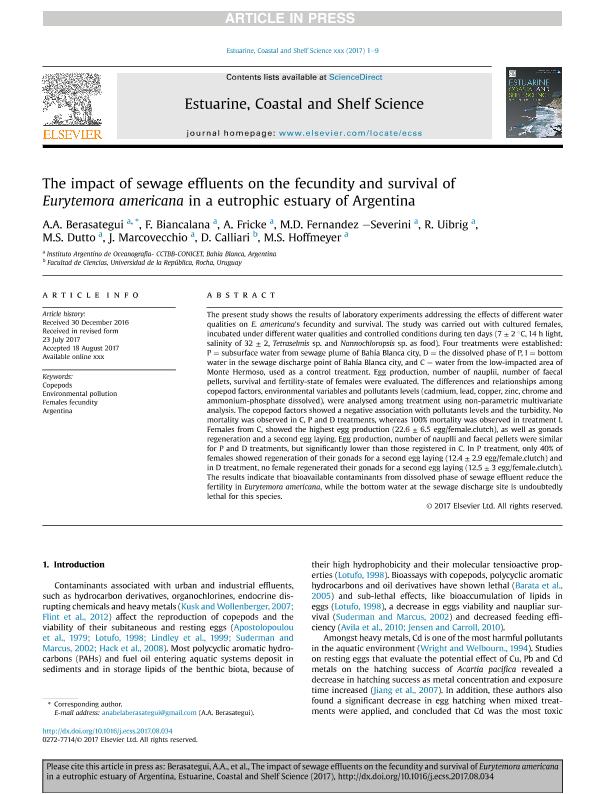Mostrar el registro sencillo del ítem
dc.contributor.author
Berasategui, Anabela Anhi

dc.contributor.author
Biancalana, Florencia

dc.contributor.author
Fricke, Anna Lena

dc.contributor.author
Fernandez Severini, Melisa Daiana

dc.contributor.author
Uibrig, Román Armando

dc.contributor.author
Dutto, María Sofía

dc.contributor.author
Marcovecchio, Jorge Eduardo

dc.contributor.author
Calliari, Danilo Luis

dc.contributor.author
Hoffmeyer, Monica Susana

dc.date.available
2017-11-17T18:07:34Z
dc.date.issued
2018-10
dc.identifier.citation
Berasategui, Anabela Anhi; Biancalana, Florencia; Fricke, Anna Lena; Fernandez Severini, Melisa Daiana; Uibrig, Román Armando; et al.; The impact of sewage effluents on the fecundity and survival of Eurytemora americana in a eutrophic estuary of Argentina; Academic Press Ltd - Elsevier Science Ltd; Estuarine, Coastal and Shelf Science; 211; 10-2018; 208-216
dc.identifier.issn
0272-7714
dc.identifier.uri
http://hdl.handle.net/11336/28462
dc.description.abstract
The present study shows the results of laboratory experiments addressing the effects of different water qualities on E. americana's fecundity and survival. The study was carried out with cultured females, incubated under different water qualities and controlled conditions during ten days (7 ± 2 °C, 14 h light, salinity of 32 ± 2, Tetraselmis sp. and Nannochloropsis sp. as food). Four treatments were established: P = subsurface water from sewage plume of Bahía Blanca city, D = the dissolved phase of P, I = bottom water in the sewage discharge point of Bahía Blanca city, and C = water from the low-impacted area of Monte Hermoso, used as a control treatment. Egg production, number of nauplii, number of faecal pellets, survival and fertility-state of females were evaluated. The differences and relationships among copepod factors, environmental variables and pollutants levels (cadmium, lead, copper, zinc, chrome and ammonium-phosphate dissolved), were analysed among treatment using non-parametric multivariate analysis. The copepod factors showed a negative association with pollutants levels and the turbidity. No mortality was observed in C, P and D treatments, whereas 100% mortality was observed in treatment I. Females from C, showed the highest egg production (22.6 ± 6.5 egg/female.clutch), as well as gonads regeneration and a second egg laying. Egg production, number of nauplli and faecal pellets were similar for P and D treatments, but significantly lower than those registered in C. In P treatment, only 40% of females showed regeneration of their gonads for a second egg laying (12.4 ± 2.9 egg/female.clutch) and in D treatment, no female regenerated their gonads for a second egg laying (12.5 ± 3 egg/female.clutch). The results indicate that bioavailable contaminants from dissolved phase of sewage effluent reduce the fertility in Eurytemora americana, while the bottom water at the sewage discharge site is undoubtedly lethal for this species.
dc.format
application/pdf
dc.language.iso
eng
dc.publisher
Academic Press Ltd - Elsevier Science Ltd

dc.rights
info:eu-repo/semantics/openAccess
dc.rights.uri
https://creativecommons.org/licenses/by-nc-sa/2.5/ar/
dc.subject
ARGENTINA
dc.subject
COPEPODS
dc.subject
ENVIRONMENTAL POLLUTION
dc.subject
FEMALES FECUNDITY
dc.subject.classification
Meteorología y Ciencias Atmosféricas

dc.subject.classification
Ciencias de la Tierra y relacionadas con el Medio Ambiente

dc.subject.classification
CIENCIAS NATURALES Y EXACTAS

dc.title
The impact of sewage effluents on the fecundity and survival of Eurytemora americana in a eutrophic estuary of Argentina
dc.type
info:eu-repo/semantics/article
dc.type
info:ar-repo/semantics/artículo
dc.type
info:eu-repo/semantics/publishedVersion
dc.date.updated
2017-11-16T14:40:57Z
dc.journal.volume
211
dc.journal.pagination
208-216
dc.journal.pais
Estados Unidos

dc.description.fil
Fil: Berasategui, Anabela Anhi. Consejo Nacional de Investigaciones Científicas y Técnicas. Centro Científico Tecnológico Conicet - Bahía Blanca. Instituto Argentino de Oceanografía. Universidad Nacional del Sur. Instituto Argentino de Oceanografía; Argentina
dc.description.fil
Fil: Biancalana, Florencia. Consejo Nacional de Investigaciones Científicas y Técnicas. Centro Científico Tecnológico Conicet - Bahía Blanca. Instituto Argentino de Oceanografía. Universidad Nacional del Sur. Instituto Argentino de Oceanografía; Argentina
dc.description.fil
Fil: Fricke, Anna Lena. Consejo Nacional de Investigaciones Científicas y Técnicas. Centro Científico Tecnológico Conicet - Bahía Blanca. Instituto Argentino de Oceanografía. Universidad Nacional del Sur. Instituto Argentino de Oceanografía; Argentina
dc.description.fil
Fil: Fernandez Severini, Melisa Daiana. Consejo Nacional de Investigaciones Científicas y Técnicas. Centro Científico Tecnológico Conicet - Bahía Blanca. Instituto Argentino de Oceanografía. Universidad Nacional del Sur. Instituto Argentino de Oceanografía; Argentina
dc.description.fil
Fil: Uibrig, Román Armando. Consejo Nacional de Investigaciones Científicas y Técnicas. Centro Científico Tecnológico Conicet - Bahía Blanca. Instituto Argentino de Oceanografía. Universidad Nacional del Sur. Instituto Argentino de Oceanografía; Argentina
dc.description.fil
Fil: Dutto, María Sofía. Consejo Nacional de Investigaciones Científicas y Técnicas. Centro Científico Tecnológico Conicet - Bahía Blanca. Instituto Argentino de Oceanografía. Universidad Nacional del Sur. Instituto Argentino de Oceanografía; Argentina
dc.description.fil
Fil: Marcovecchio, Jorge Eduardo. Consejo Nacional de Investigaciones Científicas y Técnicas. Centro Científico Tecnológico Conicet - Bahía Blanca. Instituto Argentino de Oceanografía. Universidad Nacional del Sur. Instituto Argentino de Oceanografía; Argentina
dc.description.fil
Fil: Calliari, Danilo Luis. Universidad de la República; Uruguay
dc.description.fil
Fil: Hoffmeyer, Monica Susana. Consejo Nacional de Investigaciones Científicas y Técnicas. Centro Científico Tecnológico Conicet - Bahía Blanca. Instituto Argentino de Oceanografía. Universidad Nacional del Sur. Instituto Argentino de Oceanografía; Argentina
dc.journal.title
Estuarine, Coastal and Shelf Science

dc.relation.alternativeid
info:eu-repo/semantics/altIdentifier/doi/http://dx.doi.org/10.1016/j.ecss.2017.08.034
dc.relation.alternativeid
info:eu-repo/semantics/altIdentifier/url/http://www.sciencedirect.com/science/article/pii/S0272771416307995
Archivos asociados
